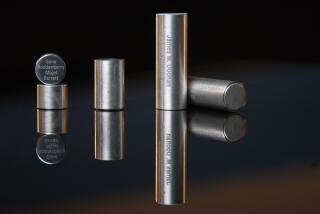America From Abroad : Two U.S. Astronauts Learning to Say ‘Beam Me Up’ in Russian : The pair are studying hard to become the first Americans to fly to the Mir space station.
- Share via
ZVYOZDNY GORODOK, Russia-- — Compared to mastering what’s known as “the great and mighty Russian language,” flying a Soviet-designed rocket to the Mir space station and spending three months in space will be a cinch.
At least, that is how it looks these days to veteran U.S. astronauts Norman Thagard and Bonnie Dunbar, in training since March to become the first Americans to fly to the Mir next year.
“I’m in the first grade and grad school at the same time,” Dunbar said recently, referring to the combination of elementary Russian and advanced space science that makes up her day. “The language is the biggest impediment--getting past the language.”
Russian is no polyglot’s picnic. The endings of nouns change, letters mutate unexpectedly and the basic vocabulary has little in common with English. If it is enough to make college students break into a sweat, think of the language stress involved for Thagard, 50, and Dunbar, 45, whose lives could at some point depend on understanding a Russian command or warning.
“There is no alternative to knowing Russian by the time we fly,” Thagard, a physician, said with grim determination.
As the first-string astronaut--Dunbar, a biomedical engineer, is his backup--Thagard expects to fly to the Mir with two cosmonauts next March and then spend three months there with its Russian crew. That would be longer than any American has spent in space. The NASA record, set in 1973-74 aboard Skylab, is 84 days; the Russians set the world record of 366 days aboard Mir in 1987-88.
The mission is notable in other ways too.
Americans and Russians haven’t worked so closely together in space since the U.S. Apollo spacecraft linked up with the Soviet ship Soyuz in 1975. Thagard will blast off in a Russian Soyuz spacecraft but expects to fly home on the American shuttle Atlantis, which will attempt to dock at the Mir.
And this is the first time that NASA will have a chance to do comparably serious in-orbit research on the physical effects of extended space travel since Skylab.
Above all, the American trip to Mir, combined with a reciprocal program for cosmonauts to fly on American space shuttles, will help lay the groundwork for the ultimate in U.S.-Russian space cooperation: an international space station, expected to begin construction in 1997 and to be known as Alpha.
“Coming at the end of the Cold War, we’re forging a new relationship,” Dunbar said, and “we (two) just come as part of a big program.”
The pair talk like the government employees they are, in diplomatic tones devoid of hype or even much excitement about the drama of their circumstances.
But drama there is, if only in that they are pioneers in America’s acquaintance with Russian cosmonauts and are paying the typical pioneer’s price in discomfort, isolation and fear of pitfalls.
The two live about 20 miles from Moscow in a characteristic Soviet-era high-rise apartment building in the campus-like town of Zvyozdny Gorodok, or Star City, former home to the first man in space, Yuri Gagarin. As in most of these buildings, the elevator can break down, and the hot water sometimes goes off.
Thagard was joined just recently by his wife and 14-year-old son, but Dunbar remains half a world away from her husband, astronaut Ronald Sega.
Phone calls can be problematic; poor Soviet phone lines make connections iffy, and the satellite phone they have with them is too expensive to use much.
Both describe the reception they have received from their Russian colleagues as “cordial” but do not sound as if they have been given any star treatment.
On the other hand, they have also not been hampered by security restrictions, unlike their American predecessors at Star City--three astronauts who visited occasionally to work on the 1975 Apollo-Soyuz mission.
The only warning the astronauts have received, Thagard said, is not to take the electric train from Star City to Moscow--a ride often populated by drunks and toughs.
“They’re worried a lot about our safety,” he said.
The two astronauts have also chosen not to drive in Russia because the traffic rules are slightly different from those in the United States. Instead, they use Russian drivers.
So, they were asked, you’re brave enough to face the perils of space but not the perils of Moscow’s roads?
“There’s no avoiding the risks of riding a rocket,” Thagard said.
The astronauts must face another great challenge before entering space: oral exams at the end of their training, all in Russian, an ordeal that has no parallel in National Aeronautics and Space Administration training.
They also cope daily with lectures in Russian on the technical aspects of their work. Thagard, who had already studied some Russian, does much of the translating for Dunbar. When he gets stuck, a Russian translator steps in.
Fortunately, the studies are not conceptually hard for them. “The principles are pretty straightforward whether you’re flying here or there,” Dunbar said. “Physics is physics, and chemistry is chemistry.”
*
Neither would nibble at questions about whether Russian equipment is more primitive than its U.S. equivalent. Thagard repeated that “the fundamental problem is one of language, not technology.”
A typical day for the pair might include four hours of Russian and two hours of practicing on a Soyuz simulator; or two hours of studying the Mir’s life-support systems, some independent study, two hours of familiarizing themselves with the Mir and two hours of serious physical workout.
They have also experienced the special Russian psychological training for long-haul space crews, which the astronauts said consists largely of yoga relaxation techniques. In the fall, they will begin working with their future flight crews.
Thagard’s research aboard the Mir will focus on the effects of prolonged space travel on the human body, in hopes of finding more ways to stem the bone loss and deterioration of the cardiovascular system that come with prolonged weightlessness.
Russian doctors have been testing cosmonauts during the eight years that Mir has been in orbit, but they did before-and-after comparisons rather than in-flight exams.
“This will be the most extensive metabolic study in space,” Thagard said.
The logic of the joint project works like this: America has the space shuttle, which can deliver cargo loads easily, but has no space station to fly it to, while the U.S. shuttles offer Russia improved cargo capacity to and from its space station.
“It’s very much a mutually cooperative program,” Dunbar said. Four other astronauts will follow Thagard and Dunbar to Star City for training in coming months, and 10 shuttle-Mir dockings are planned.
Dunbar and Thagard are already planning the friendly gesture to cement that cooperation. When they return from their flight, Thagard said, they will lay flowers at Star City’s monument to Yuri Gagarin--just as all the other cosmonauts do.
More to Read
Sign up for Essential California
The most important California stories and recommendations in your inbox every morning.
You may occasionally receive promotional content from the Los Angeles Times.










